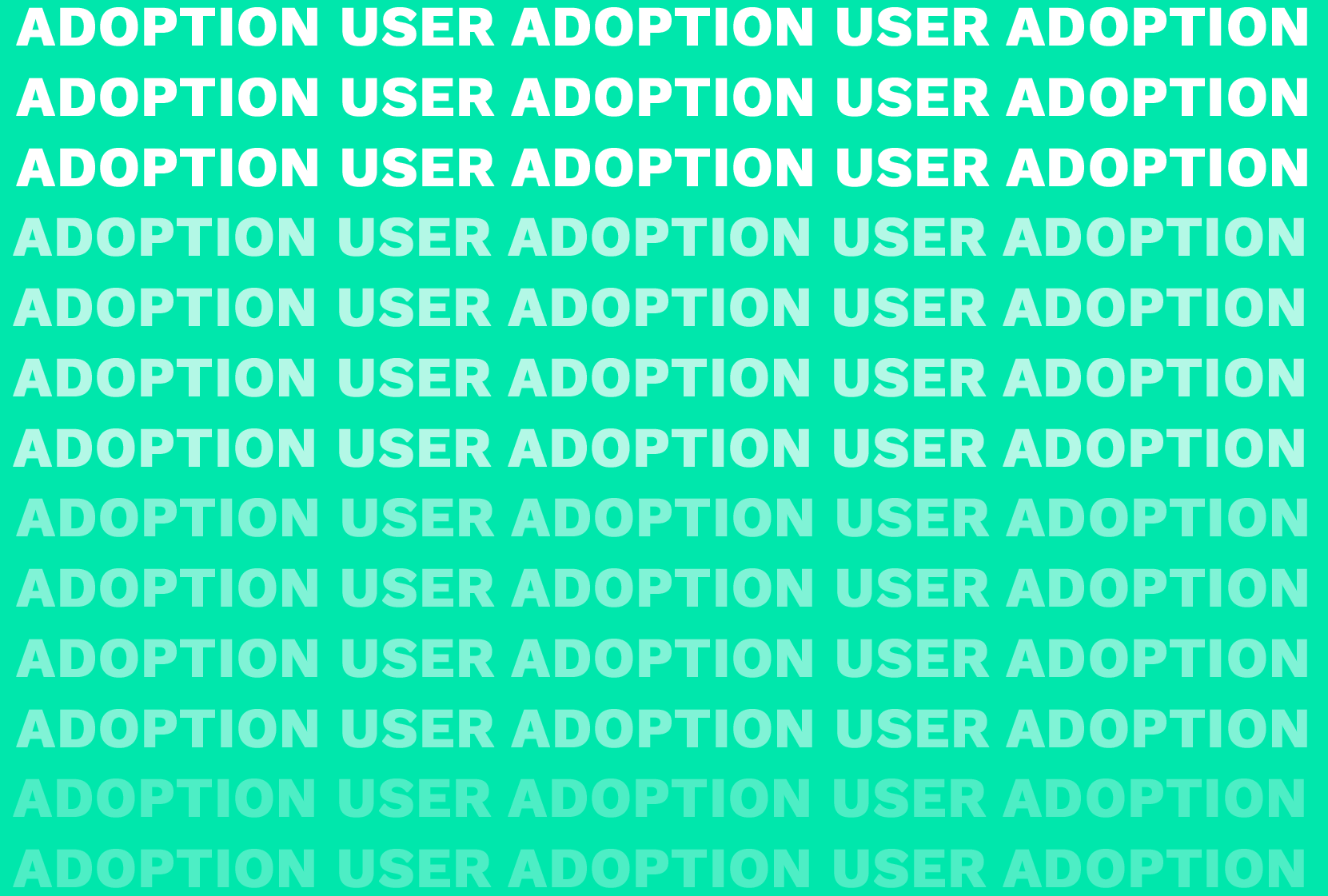Viele Unternehmen finden es schwierig, den Prozess der Softwareeinführung zu verfolgen. Nach Angaben von Really Simple Systems war das größte Hindernis für 83 Prozent der Führungskräfte, ihre Mitarbeiter dazu zu bringen, die Software zu nutzen und anzunehmen. Wenn Sie versuchen, ein neues CRM-Framework, eine Zeiterfassung, ein Marketing-Hub oder etwas anderes einzuführen, müssen Sie sicherstellen, dass das Unternehmen für den Erfolg gerüstet ist, bevor Sie beginnen.
In diesem Artikel:
- Softwareübernahme vs. Produktübernahme vs. Benutzer-/Kundenübernahme
- Strategien zur Einführung von Software
- Auswahl einer Einführungsstrategie
- Prozess der Vorbereitung einer Organisation auf die Einführung von Software
- Herausforderungen für eine erfolgreiche Softwareeinführung
- Fünf Schritte zur erfolgreichen Einführung von Software
- Produktakzeptanzraten
- KPIs zur Messung der digitalen Akzeptanz von Software
Softwareübernahme vs. Produktübernahme vs. Benutzer-/Kundenübernahme
Schauen wir uns zunächst an, wie wir Software-Adoption im Vergleich zu Produktadoption, Kunden-/Nutzeradoption definieren können.
| Einführung von Software | Einführung des Produkts | Benutzerakzeptanz | Kundenakzeptanz | |
|---|---|---|---|---|
| Mittelwert -ing | Der Transfer zwischen alter Software und Zielsoftware in einem Unternehmen (oder, allgemeiner, von jedem). | Der gesamte Prozess, bei dem eine Person ein neues Produkt ausprobiert und zu einem regelmäßigen Nutzer wird. | Die Übertragung von einem alten System auf einen Benutzer, der ein neues System einführt. | Die Gewinnung neuer Kunden, die die Produkte oder Dienstleistungen des Unternehmens nutzen. |
| KPIs | * Benutzeranmeldungsraten * Aktualisierungsraten * Erstellung von Kontakten * Erstellung/Aktualisierung von Verkaufschancen * Abschluss von Aktivitäten * Offene/abgeschlossene Aufgaben * Chatter-Nutzung | * Akzeptanzrate * Zeit bis zur ersten Aktion * Anzahl der Nutzer, die die Funktion nutzen * Gesamtzahl der Nutzungen einer Funktion | * Akzeptanzrate * Zeit bis zur ersten Aktion * % der Nutzer, die die Funktion zum ersten Mal verwenden | * Adoptionsrate * Zeit bis zur ersten Schlüsselaktion * Zeit bis zur Wertschöpfung * Zufriedenheit, Beherrschung und Nutzung |
| Adop -tionStufen | (1) Sicherstellen, dass das Unterstützungsteam involviert ist (2) Kommunizieren (3) Interne Verfechter finden (4) Schulungsveranstaltungen durchführen (5) Internes Marketing | (1) Sensibilisierung (2) Informationsbeschaffung (3) Bewertung/Überlegung (4) Erprobung (5) Annahme | (1) Sensibilisierung (2) Interesse (3) Bewertung (4) Erprobung (5) Adoption | (1) Sensibilisierung (2) Interesse (3) Bewertung (4) Erprobung (5) Adoption |
Strategien zur Einführung von Software
Software-Akzeptanz-Strategien helfen einem Unternehmen, die Benutzer in die Lage zu versetzen, eine neue Software als internes CRM zu nutzen. In den meisten Unternehmen werden nur etwa 50 % der CRM-Funktionen , für die die Unternehmen bezahlen, von ihren Mitarbeitern genutzt.
CRM ist heute das Herzstück eines jeden wachsenden Unternehmens. Berichten zufolge wird CRM bis 2025 voraussichtlich einen Umsatz von mehr als 80 Milliarden Dollar erzielen. Die Zugänglichkeit ist einer der wichtigsten Wachstumsfaktoren im CRM. Unternehmen können jetzt in Echtzeit auf Kundendaten zugreifen (Kundendienst, E-Mail-Marketing usw.), wobei mobile und Cloud-Lösungen den Weg weisen.
Unternehmen haben erkannt, dass CRM dabei hilft, Plattformen und Technologien mit Kundendaten zu verbinden, um ein personalisiertes Erlebnis zu schaffen, das einen großen Einfluss auf die Erfüllung von Verkaufsquoten hat.
Für die Einführung von Software in einem Unternehmen gibt es eine Reihe von Einführungsmethoden. Big Bang Adoption, parallele Adoption und schrittweise Adoption sind die wichtigsten Methoden. Eine weitere ungewöhnliche Methode ist die Pilotanwendung.
Urknall-Adoption
Wenn ein neues System ohne Übergangszeit zwischen dem bestehenden und dem neuen System eingeführt wird, spricht man von einer Big-Bang-Adoption oder einer direkten Umstellung. Der Vorteil einer "Big Bang Adoption" besteht darin, dass das neue System nicht mit bestehenden Systemen kompatibel sein oder mit ihnen verbunden werden muss.
Dies vereinfacht die Gestaltung des neuen Systems erheblich, insbesondere in einem Unternehmen mit vielen inkompatiblen Systemen. Sie ist jedoch risikoreicher als andere Formen der Übernahme, da weniger Lernressourcen in die Strategie eingebaut sind und mehr Planung erforderlich ist.
Parallele Übernahme
Eine Strategie für den Übergang von einem früheren (IT-)System zu einem neuen (IT-)System in einem Unternehmen wird als Paralleladoption bezeichnet. Um das Risiko zu minimieren, werden das alte und das neue System für eine gewisse Zeit parallel betrieben, während der das alte System entfernt wird, wenn die Anforderungen des neuen Systems erfüllt sind.
Das Verfahren erfordert eine sorgfältige Vorbereitung und Überwachung sowie einen erheblichen Aufwand an Arbeitsstunden. Dieser Beitrag konzentriert sich auf die allgemeine Methode der Paralleladoption; gegebenenfalls werden (reale) Illustrationen verwendet, um ein besseres Verständnis des Prozesses zu vermitteln.
Schrittweise Annahme
Die Methode, eine Innovation (z. B. Informationstechnologie, Softwaremigration, Prozesse usw.) gestaffelt in einer Organisation einzuführen, wobei verschiedene Teile der Organisation in unterschiedlichen Zeitfenstern übernommen werden, wird als phasenweise Übernahme bezeichnet. Weitere Bezeichnungen sind Phased Adoption, Phased Migration, Phased Solution, Phased Plan, Phased Introduction und Staged Conversion.
Pilot-Annahme
Der Ansatz der Piloteinführung findet sich in multinationalen Organisationen mit vielen Standorten oder Abteilungen, die völlig autonom sind. Die neue Struktur wird zunächst an einem der Standorte oder in einer der Abteilungen eingeführt und dann schrittweise auf andere Standorte oder Abteilungen ausgeweitet.
Auswahl einer Einführungsstrategie
Bevor die Einführung beginnt, muss der Einführungsplan festgelegt werden, der von den gewünschten Ergebnissen und der Art der einzuführenden Methode abhängt. Big Bang, parallele Einführung und gestaffelte Einführung sind drei Formen der Einführung, die von einem sofortigen Übergang bis hin zu einer Methode reichen, bei der die Menschen die neue Technologie schrittweise über einen bestimmten Zeitraum (der Wochen, Monate oder sogar Jahre betragen kann) nutzen.
Nach dem Buch von Ken Eason wird die endgültige Entscheidung durch die Priorisierung der zu erreichenden Ziele und die Abstimmung eines Plans auf diese Ziele getroffen. Die folgenden Ziele werden von Eason beschrieben:
- Damit das System funktioniert, könnte eine "kritische Masse" erforderlich sein
- Wenn es ein Risiko gibt, ist ein Risikomanagement erforderlich
- Erleichterung des Wandels ist erforderlich
- Die Geschwindigkeit des Übergangs
- Lokale Designanforderungen

Prozess der Vorbereitung einer Organisation auf die Einführung von Software
Die möglichen Änderungen müssen festgelegt werden, um die Organisation für die Einführung der neuen Software zu planen. Dies ist wichtig, um einen Zeitplan oder eine Übersicht über den Übergang zu erstellen, und kann durch das Schreiben von Rahmenspezifikationen erreicht werden.
Nachdem die Bedingungen festgelegt wurden, muss die Unternehmensleitung ihnen zustimmen, bevor sie mit dem Übergangsplan fortfahren kann. Wird kein Konsens erzielt, muss die Unternehmensleitung die Bedingungen erneut prüfen, bis sie eine Einigung erzielt. Wenn eine Einigung erzielt und ein Vertrag unterzeichnet wird, kann das Unternehmen zur nächsten Phase übergehen.
Herausforderungen für eine erfolgreiche Softwareeinführung
- Widerstand gegen Veränderungen
- Fehlen einer praktikablen Einführungsstrategie
- Datenmanagement und -analyse sind nicht auf der Höhe der Zeit
- Ein Benutzererlebnis, das nicht für die Lernfähigkeit optimiert ist
Fünf Schritte zur erfolgreichen Einführung von Software
- Unterstützung des Teams sicherstellen
- Gut kommunizieren
- Interne Teamleiter finden
- Schulungsveranstaltungen durchführen
- Interner Markt
Produktanwendungsraten
Die Nutzeraktivierung für eine Web- oder Smartphone-Anwendung wird durch die Produktakzeptanz gemessen. Sie kann als Rate im Verhältnis zu den Anmeldungen für ein bestimmtes Datum oder als Anzahl über einen bestimmten Zeitraum ausgedrückt werden, z. B. als monatlich aktive Nutzer (MAU). Monatliche Produktakzeptanzrate (in Prozent) = [neue MAU / monatliche Anmeldungen] * 100, zum Beispiel.
Stickiness ist eine Kennzahl, die von mehreren Unternehmen zur Messung der Produktakzeptanz verwendet wird. Die Anzahl der Nutzer, die sich mindestens ein Mal bei dem Produkt anmelden, wird als "Stickiness" bezeichnet und als Zahl über die Zeit ausgedrückt. Die Definition des Begriffs "Aktivierung" hat sich geändert, aber der Großteil der Definition der Produktakzeptanz ist unverändert geblieben.
KPIs zur Messung der digitalen Akzeptanz von Software
Die KPIs zur Messung der digitalen Akzeptanz lassen sich in vier Kategorien einteilen:
- Ergebnisse
- Eigenschaften
- Zufriedenstellung
- Absicht
Ergebnisse
Diese Untergruppe von KPIs hat wenig mit dem Konzept der digitalen Einführung zu tun. Vielmehr ist sie mit ihrer Funktion verbunden. Das Ziel der digitalen Einführung ist es, die menschliche Leistung zu steigern und es für Arbeitnehmer und/oder Verbraucher einfacher und schneller zu machen, hervorragende Ergebnisse zu erzielen. Ziel ist es, die menschliche Leistung und alle damit zusammenhängenden Ursachen, wie z. B. die Effizienz, zu verbessern.
Eigenschaften
Wenn die Menschen nicht alle Funktionen eines neuen Tools kennen oder zu schätzen wissen, würde es nicht effektiv eingesetzt werden. Eine Bank kann zum Beispiel eine neue App für ihre Kunden einführen, die die Möglichkeit bietet, einen Bankscheck zu Hause auszudrucken. Die Kunden sind mit dem Konzept des Online-Bankings vertraut und freuen sich darüber, so dass die Banking-App rege genutzt wird. Andererseits kennen die Kunden die neue Funktion des Bankschecks überhaupt nicht.
Zufriedenstellung
Diese Sammlung von KPIs bezieht sich speziell auf die Nutzer des betreffenden interaktiven Tools. Es gibt einige Metriken, die zur Bewertung der Nutzerzufriedenheit herangezogen werden können .
- Allgemeine Kundenerfahrung
- Das Tempo der Erledigung der geplanten Aufgabe
- Anzahl der Besucher, die wahrscheinlich wiederkommen werden
- Anzahl der Besucher, die gerne Empfehlungen abgeben
Absicht
Wozu wird die aktuelle Erfindung oder das aktuelle Gerät verwendet? Was ist der Zweck? Welche Anforderungen muss sie erfüllen, und welche Probleme sollen damit gelöst werden? Die beabsichtigten KPIs können auf den Antworten auf diese Fragen basieren. Wenn beispielsweise eine Automatisierung eingeführt wird, um die Verkaufsabläufe zu beschleunigen, können Sie verfolgen, wie viel Zeit für jeden einzelnen Vorgang aufgewendet wird.
Wenn Ihr Unternehmen einen Chatbot einführt, um das Kundendienstzentrum zu entlasten, können Sie die Anzahl der Anrufe im Zentrum sowie die Nutzung des Chatbots überwachen.
Abschließende Überlegungen zur Softwareeinführung
Die Einführung von Software in einem Unternehmen ist ein harter Kampf. Aber es ist ein notwendiger Kampf. Wenn ein Unternehmen seine Zeit und Mühe investiert, um die besten Adoptionsraten und die beste Software für sein Unternehmen zu finden, und dem Unternehmen und den Mitarbeitern Zeit und Raum zum Lernen und Wachsen gibt, wird es in der Lage sein, die Software richtig zu implementieren und dabei viele Vorteile zu erzielen. Die Einführung von Software ist also für alle von immenser Bedeutung.














